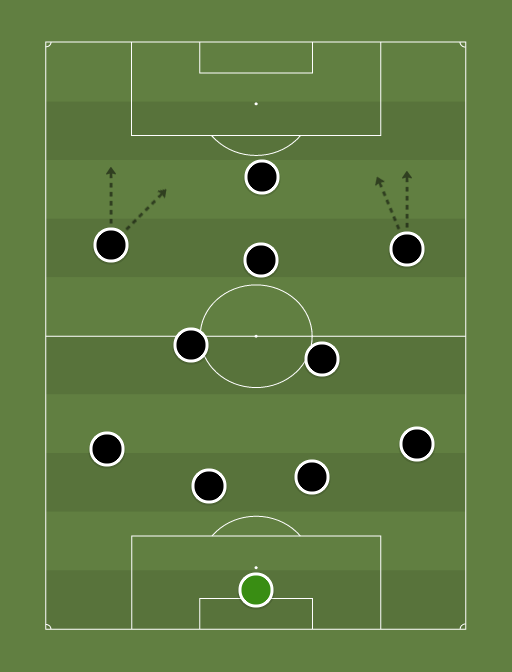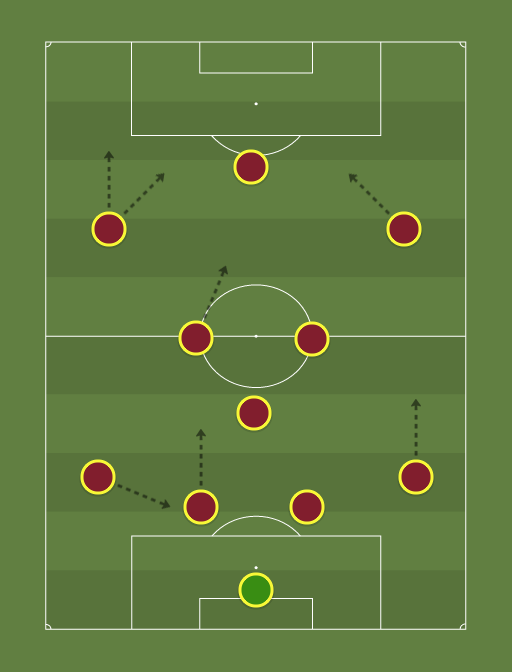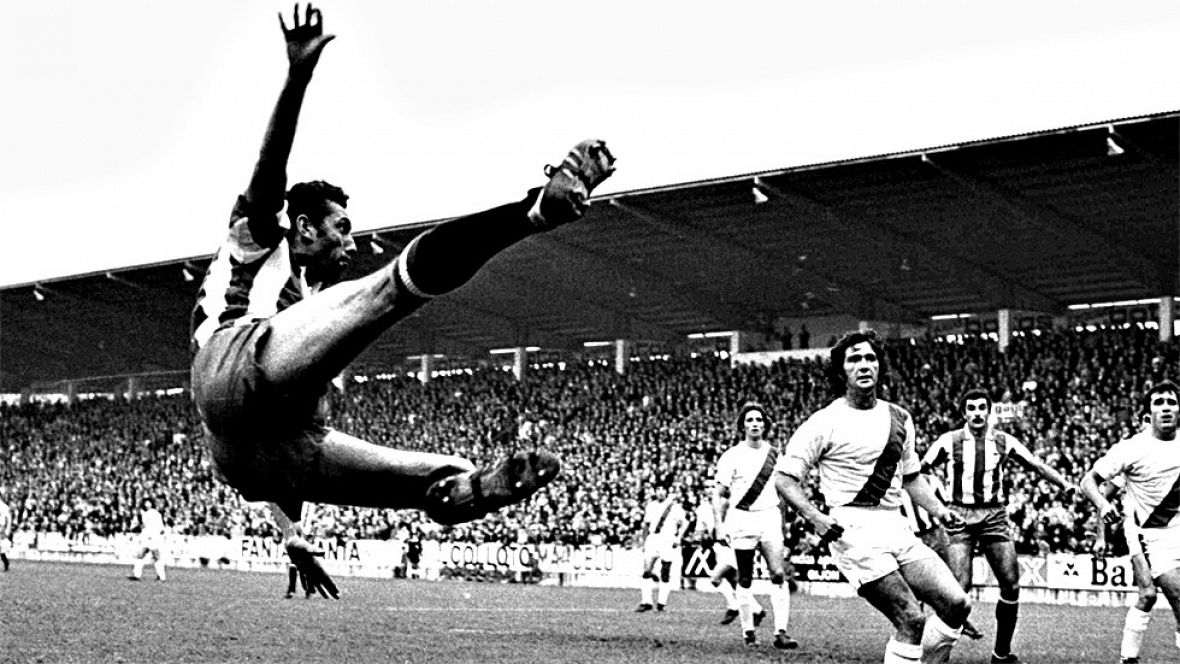Modern football has become so sanitised in this day and age that it’s hard to recall if there was ever a time that top European football players were always so readily approachable. Teams of security personnel, management consultants and the like pore over just about every detail and facet of a player’s life that it’s hard to reconcile their mode of living as being in the real world.
Back in the late 1970s and early 1980s, even the superstars of Real Madrid and Barcelona would stop and chat with supporters after a game, happily signing autographs and posing for photos. The working-class element of the game that wove a thread through every club was just as prevalent at Spain’s big two as it was anywhere else. The sense of being at one with those who paid their hard-earned peseta was palpable.
Enrique Castro ‘Quini’ González was the serial Pichichi of his day and a player so revered by team-mates and opponents alike that he attained an almost God-like status in Spain. Yet he would never let his achievements or popularity get in the way of spending time with his adoring public.
He was born in Oviedo, the capital city of the Asturian region of Spain, on 23 September 1949, to María Elena González García and Enrique Castro. Though the family were well settled, and Quini would spend the early part of his formative years there, his father’s relocation to the Ensidesa steel manufacturing company meant a move some 35 kilometres north to Llaranes.
The area, known as
El Poblado, was built to house some 8,000 new inhabitants, almost all of whom would work for the company. Indeed, the land that was primarily built upon was directly in front of their place of work – a stark behemoth of a factory which oozed toxic smoke day in and day out, casting a dark shadow across town. Excavations at the time unearthed many Roman coins and several axes from the Neolithic period, and these can still be found at museums in the locale.
Quini took the new start in his stride, despite his young age and having had to leave childhood friends behind. It was perhaps the earliest example of the incredible mental strength that he possessed and which would stand him in good stead for one of the most unsavoury situations of his adult life – an incident which would’ve broken lesser mortals.
Both María and Enrique Snr. took care to ensure their son’s transition to a new school and environment was the least painful it could be, and the ease with which he settled suggested to Quini’s parents that they’d made the right choices.
A love for football had already been passed down from father to son and it wasn’t uncommon to find Quini out with a ball and looking to play until the sun began to set. Initially, there was a need for the youngster to evidence to his neighbours, friends and classmates that he could handle the rough stuff too. Llaranes wasn’t an area where one showed weakness and, being the new boy in town, he had to ride out that particular storm too.
As he began to mature, becoming a stocky adolescent with a rifle-like shot, he would often enjoy a kick-about with boys quite a bit older than himself. The occasional battering was welcomed because it helped Quini learn the rudiments of that side of the game and toughened him up in the process. Shirt pulling, raking of studs down the back of his calves, it was all in a day’s work, whether it was at school, playing for his modest junior team, Don Bosco, or just on the streets with friends.
Quini’s love of all aspects of the game was infectious and by the time he made it as a professional, all of the tricks of the defensive trade and how to combat them were known.
He continued to learn his craft whilst playing for the youth teams of Club Deportivo Ensidesa. Formerly Club Deportivo Llarenes, it was taken over by his father’s company two years prior to Quini’s debut season in the first team as an 18-year-old in 1967. By then it had essentially become the works team and though consistently in the Tercera División (third tier) at the time, it was nevertheless a well-run amateur club.
Ensidesa were a big employer in Avilés, an industrial town a couple of miles from the suburb of Llanares. Real Avilés were another local team and one who would begin to falter as Ensidesa worked their way up to the Segunda División for the first time in their history. Eventually it made sense to pool resources and the new Real Avilés still survives today.
By that time, Quini had left. He was a revelation; 17 goals in 22 games brought him huge local attention. His father had understood that his son was special, but it was only during the 1967-68 season that the penny had truly dropped. Sporting Gijon had been alerted to this wunderkind and his incredible striking prowess, and negotiations between the two teams were swift and cordial as might’ve been expected.
Far from showing any nervousness in his debut campaign, Quini hit the ground running, surprising even the most experienced of defenders in the Segunda with his strength and eye for goal. With 15 goals to his name by the end of the season, he had surpassed all expectations and went on to prove that he was no one-season wonder either. There was no stopping him or Sporting as they ended the following season on top of the pile and were promoted to the Primera División.
A mixture of quick feet, strength, aerial and finishing ability was a nightmare for any opposition to contend with and defences were continuously annihilated in the Spanish top flight. In 11 seasons at Sporting, only once did
Quinigol, as he became known, fail to hit double figures.
Barcelona had tried, and failed, on several occasions to prise him from the Asturians but, after scoring 215 goals in 380 appearances, the time was right to consider a change.
By the time that the Catalans finally got their man in 1980, he was 31, but still cost the Blaugrana 82 million pesetas of their budget. The Spanish papers were awash with critique that suggested Barça had been sucked into paying over the odds but after top scoring in his opening two seasons at Camp Nou, it was Barça who laughed last.

However, during that period came Barcelona’s darkest hour and unquestionably one of the worst episodes in football history. Sunday, 1 March 1981, was a day that changed Quini’s life forever. Having scored twice to help Barça destroy Hércules 6-0 at Camp Nou, he left the stadium and was on his way to the airport to collect his wife, Maria Nieves, and their children.
Kidnapped at gunpoint by a group known as the Batallon Catalano-Espanyol, he was destined never to complete that particular journey. Filing a missing person’s report later in the day, Maria was out of her mind, but far from getting better, the situation got much worse just a day later.
Without sleep, the family were at their wits end and then came the news that
La Vanguardia had received a call from one of Quini’s captors. On 8 March, Barça were due to play Atlético Madrid and for all intents and purposes, Quini had been taken to ensure that he didn’t play any part. “The team cannot win the ‘separatists’ league,” his captors would remark.
Barcelona were in second place at the time, two points behind Atleti, but were the form team heading into that fixture. Quini’s absence would have a significant impact on their ability to win the match – not that anyone wished to play it once the details of what had happened filtered out into the public domain.
Bernd Schuster was one of the first players to stick his head above the parapet and tell anyone who wished to listen that he wasn’t in the right frame of mind for football. Team-mates quickly followed suit. Football could take a back seat for now. Spanish football remained in shock because this sort of thing just didn’t happen. Sadly, it had happened, and now the conspiracy theories came thick and fast.
A tense political atmosphere at the time hardly helped in calming the noise surrounding the incident and it was three days before Quini’s wife Maria received a call detailing the captors’ ransom demands. It came at 11.30pm local time and she was in no mood to dance to their tune.
Local police, unsure at first if the call was genuine, took their time in assessing its validity. Subsequent similar calls continued on a daily basis and news coverage was carefully coordinated between police and newspaper editors in order that they, rather than the captors, remained in some form of control. A carrot and stick approach over the demands if you will.
Club president, Josep Lluís Núñez, and Quini’s team-mates, José Ramón Alexanko and Segura, looked after Maria and her children, fearing for their safety, It was as far removed from the preparation required for Barça’s biggest match of the season as it’s possible to be.
Without any sign whatsoever of Quini being released, his colleagues were coerced against their will to take part in the game at the Vicente Calderón. A 1-0 defeat was hardly a surprise given the circumstances and Schuster was incandescent when talking to the press afterwards.

Both club coach,
Helenio Herrera, and President Núñez were squarely blamed for the loss and the club captain even went as far as questioning their abilities for their respective positions. The atmosphere had turned poisonous and it wasn’t going to recover anytime soon. Any petty in-fighting would have to wait until Quini’s release had been secured.
On the pitch, things went from bad to, well, horrific. Genuine title contenders before Quini’s capture, Barcelona took just a single point from their next five games. All the while the club were still trying to go about their business as best they could, leaving the police to keep a close eye on everything else. Each day, Maria would receive a call from the kidnappers but they were never on the phone long enough for a trace to be effective. We are talking well before the digital age of course.
With genuine fears that Quini might never be seen again, a breakthrough was made after the kidnappers spoke to Alexanko – by this point it had been three weeks since the striker had disappeared. An amount of 100 million pesetas – to be paid into a Swiss bank – would secure Quini’s release, unharmed.
With the weight of the Spanish footballing public behind them, chief of police, Francisco Álvarez Sánchez and his Swiss counterpart decided it was the right time to act. Amidst complete secrecy, save for Barcelona and Swiss authorities being kept in the loop, Victor Manuel Díaz Esteban was the recipient of a cool 100 million.
Greed would get the better of him in Geneva on 25 March as he withdrew just one million pesetas. It had taken almost two days of patience, of sleepless nights and of what if’s, but the tireless work of Álvarez Sánchez and his team had paid off. The lead took them to a garage in Zaragoza and three unemployed Spaniard’s were apprehended. Quini, despite his significantly traumatic ordeal, looked in remarkable health but was clearly exhausted – perhaps mentally more so than physically.
Stockholm Syndrome appeared to be setting in, which was of most concern. Quini refused to press charges against his captors suggesting he’d been well treated and even after they were sent to jail and ordered to pay him five million pesetas some six months later, the player didn’t – and still hasn’t – claimed his damages.
It’s incredible that to think just a few weeks after his release, the striker was back in the groove again, afforded rousing standing ovations at every ground. He was as popular then as ever, but the question marks over his career were many. His answer was emphatic. Scoring two goals against his old employers, Sporting, helped to win Barcelona the Copa del Rey and he’d go on to be top scorer at the end of the season – despite missing almost a month of it.
On 15 January of the following year, the case against his kidnappers was eventually heard and they were sentenced. As if to bookend the incident, just five days after that Barcelona’s 3,000th goal would be scored – by Quini, of course.
It drew a line under the entire episode but not his career. After another campaign, he would head back to Sporting at age 35 before retiring a genuine Spanish football legend three seasons later










 ) and he's a cracking winger.
) and he's a cracking winger. )
)